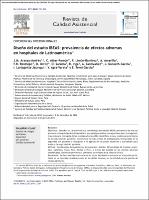| dc.contributor.author | Aranaz Andres, J. M. | |
| dc.contributor.author | Aibar Remón, Carlos | |
| dc.contributor.author | Limón Ramírez, R. | |
| dc.contributor.author | Amarilla, A. | |
| dc.contributor.author | Restrepo, F. R. | |
| dc.contributor.author | Urroz, O. | |
| dc.contributor.author | Sarabia, O. | |
| dc.contributor.author | Inga, R. | |
| dc.contributor.author | Santivañez, A. | |
| dc.contributor.author | Gonseth García, J. | |
| dc.contributor.author | Larizgoitia Jauregui, I. | |
| dc.contributor.author | Agra Varela, Y. | |
| dc.contributor.author | Terol García, E. | |
| dc.date.accessioned | 2019-04-24T17:01:02Z | |
| dc.date.available | 2019-04-24T17:01:02Z | |
| dc.date.issued | 2011 | |
| dc.identifier.citation | Revista de Calidad Asistencial. 2011; 26(3). | es_PE |
| dc.identifier.uri | https://hdl.handle.net/20.500.12959/431 | |
| dc.description.abstract | Objetivos: Describir las características y metodología del estudio IBEAS: prevalencia de efectos adversos en hospitales de Latinoamérica, que persigue realizar una aproximación a la magnitud, trascendencia e impacto de los eventos adversos (EA); identificar áreas y problemas prioritarios de la seguridad del paciente; incrementar la masa crítica de profesionales involucrados en la seguridad del paciente e incorporar a la agenda de los países objetivos y actividades para mejorar la seguridad del paciente.
Método: Estudio sobre la seguridad de los pacientes. Ámbito: 35 hospitales de 5 países: Argentina, Colombia, Costa Rica, México y Perú, a través del análisis de los efectos adversos identificados. Diseño de prevalencia utilizando la revisión de la historia clínica.
Resultados: Se describen las implicaciones en el uso del diseño transversal en el estudio de EA, tanto en los recursos necesarios como en la validez interna y en la utilidad para la gestión de riesgos sanitarios.
Conclusiones: El diseño transversal es eficiente en tiempo y recursos y fácil de realizar, y aunque no permite estudiar la totalidad del episodio de hospitalización, ha demostrado ser capaz para sostener un sistema de vigilancia. Debido a un posible sesgo de supervivencia, los EA que ocasionen un ingreso se verán sobrerrepresentados, y también aquellos relacionados con la infección nosocomial o los que sean difícilmente identificables si no se ve al paciente. La comunicación con el personal de planta (mientras el paciente está hospitalizado) favorece el juicio de la causalidad del efecto adverso y de su evitabilidad. | es_PE |
| dc.description.abstract | Objectives: To describe the methodological characteristics of the IBEAS study: adverse events prevalence in Latin American hospitals, with the aim of analysing the magnitude, significance and impact of adverse events (AE); to identify the main problems associated with patient safety AE; to increase the capacity of professionals involved in patient safety; and the setting up of patient safety agendas in the participating countries.
Methods: A patient safety study launched in 35 Latin American hospitals through the analysis of AE in 5 countries: Argentina, Colombia, Costa Rica, Mexico and Peru, using a cross-sectional study using a review of clinical records as the main method.
Results: The implications of using a cross-sectional design when studying AE are described, in terms of resources required, internal validity and usefulness related to risk management.
Conclusions: The cross-sectional design seems an efficient methodology in terms of time and resources spent, as well as being easy to carry out. Although the cross-sectional design does not review the all hospital episodes, it is able to provide a reliable estimate of prevalence and to support a surveillance system. Because of a possible survival bias, it is likely that the AE which led to hospital admissions will be overestimated, as well as the health related infections or those adverse events which are difficult to identify if the patient is not examined (e.g. contusions). Communication with the ward staff (if the patient is still hospitalised) help in finding the causality and their prevention. | |
| dc.format | application/pdf | es_PE |
| dc.language.iso | spa | es_PE |
| dc.publisher | Sociedad Española de Calidad Asistencial | es_PE |
| dc.relation.uri | https://www.sciencedirect.com/science/article/abs/pii/S1134282X11000261 | |
| dc.rights | info:eu-repo/semantics/openAccess | es_PE |
| dc.rights.uri | https://creativecommons.org/licenses/by-nc-nd/4.0/ | es_PE |
| dc.source | Seguro Social de Salud (EsSalud) | es_PE |
| dc.source | Repositorio Institucional EsSalud | es_PE |
| dc.subject | Ciencias del Cuidado de la Salud y Servicios | es_PE |
| dc.subject | Gestión de Riesgos | es_PE |
| dc.subject | Seguridad del Paciente | es_PE |
| dc.subject | Calidad de la Atención de Salud | es_PE |
| dc.subject | Risk management | |
| dc.subject | Safety management | |
| dc.subject | Quality of health care | |
| dc.title | Diseño del estudio IBEAS: prevalencia de efectos adversos en hospitales de Latinoamérica | es_PE |
| dc.title.alternative | IBEAS design: adverse events prevalence in Latin American hospitals | |
| dc.type | info:eu-repo/semantics/article | es_PE |
| dc.subject.ocde | https://purl.org/pe-repo/ocde/ford#3.03.05 | es_PE |
| dc.publisher.country | PE | es_PE |
| dc.identifier.doi | https://doi.org/10.1016/j.cali.2010.12.001 | |






